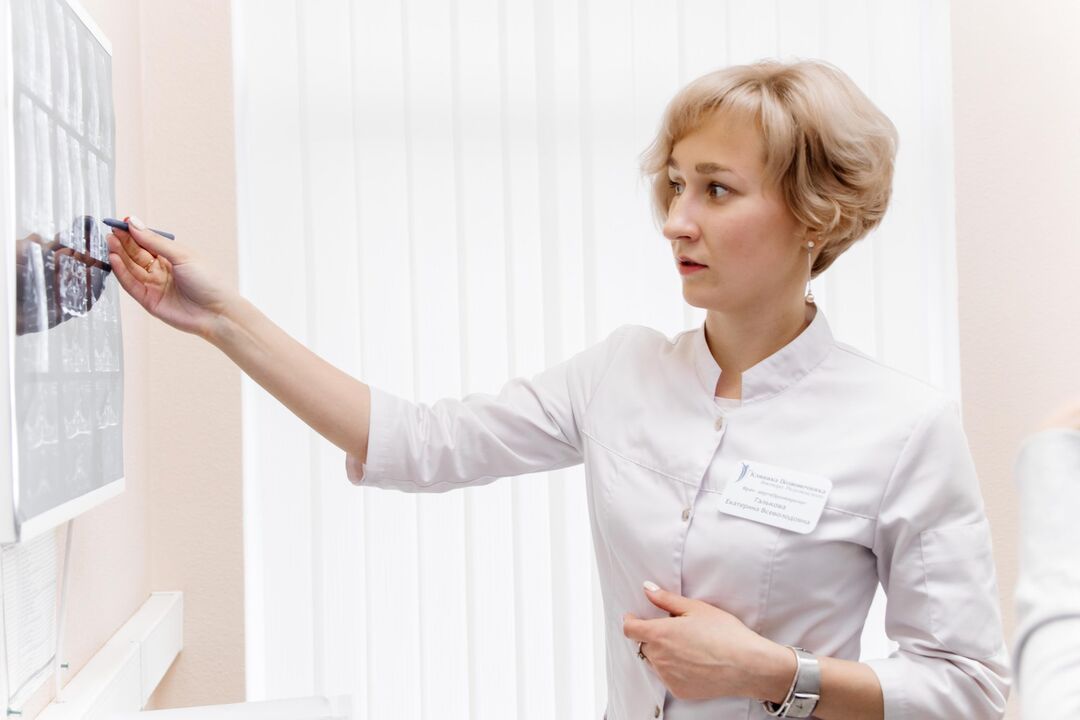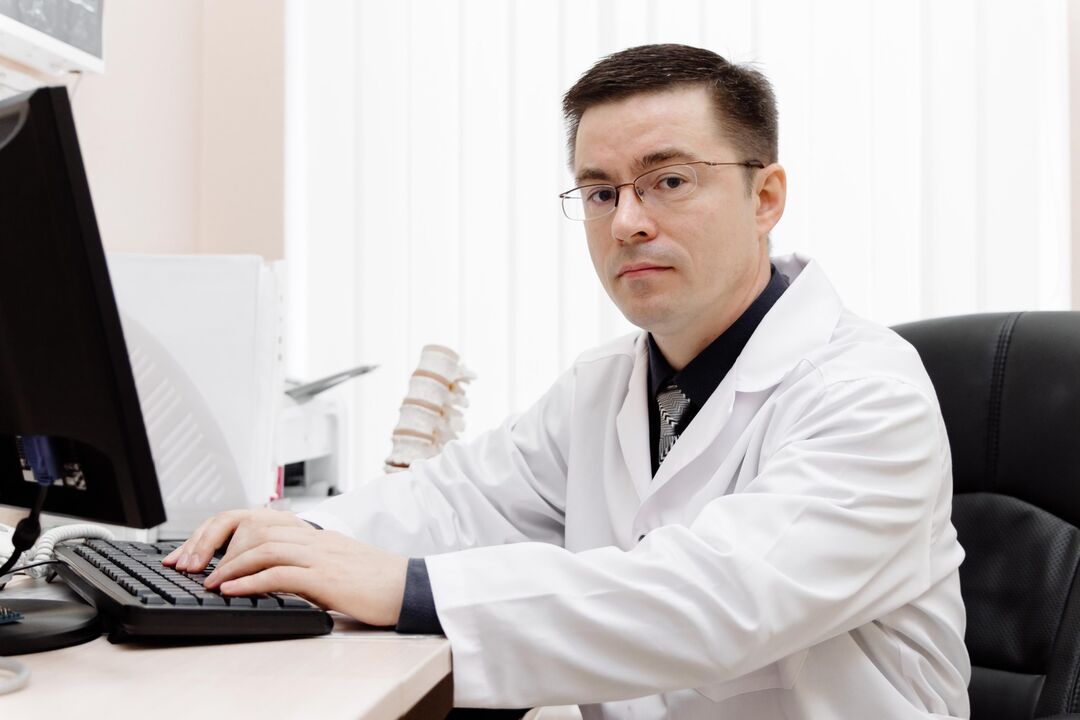Cervical osteochondrosis is a degenerative disease in which the intervertebral discs thin, causing changes in the anatomy of the cervical spine and damage to nearby nerve endings and blood vessels. As the degradation process progresses, it also covers the surrounding structures. The disease is characterized by a range of symptoms, such as neck pain, dizziness, nausea, limited spinal mobility, and significantly impairs the patient's quality of life.

What is cervical osteochondrosis
The cervical region is the most mobile part of the spine. It consists of 7 vertebrae with the intervertebral disc in the middle. The latter ensures the integrity of the area and performs the function of shock absorption. The disc has a complex structure: inside there is a pulp surrounded by a dense ring of fibers.
The height of the intervertebral disc decreases with age and the effect of increased load. Metabolism in the nucleus is disturbed and cracks appear in the annulus fibrosus. As the disease progresses, the disc herniates, bulges and hernias develop. Osteophytes appear - bone growths that limit spinal mobility and cause pain.
Pathological changes occur near the spinal cord and nerve roots. When they are compressed, muscle reflex spasms occur. In this case, a person has obvious symptoms of cervical osteochondrosis.
cause of disease
Osteochondrosis develops under the influence of a variety of causes. There are several theories that explain the nature of the disease:
- Degeneration - the cause of osteochondrosis of the cervical spine is the wear and tear of the intervertebral discs;
- body - the development of the disease due to excessive influence on the vertebrae and discs;
- Autoimmunity - a person's own immunity can damage the discs over time;
- Blood vessels - the nutrition of cartilage and bone tissue is disturbed, which is associated with pathological changes in blood vessels;
- Genetic Predisposition - This disorder occurs in people who are predisposed to developing spinal degenerative diseases.
important! No one theory is more likely to explain the cause of cervical osteochondrosis.
The predisposition to this disorder may be a combination of several factors:
- Incorrect posture, flat feet;
- Sedentary work, sedentary lifestyle;
- excess weight;
- Spinal injuries and congenital lesions;
- excessive physical activity;
- hormonal changes;
- bad habits;
- vascular disease;
- Genetic susceptibility.
The more these factors are combined, the greater the likelihood of disease and the faster the malnutrition process.
Symptoms of cervical osteochondrosis
Symptoms of cervical osteochondrosis do not appear right away. For a long time, the patient may be unaware of the onset of the disease and only focus on health after the onset of pain.

In the first stage of the disease, when the thickness of the intervertebral disc is slightly reduced, you may experience mild neck discomfort if you are in an uncomfortable position for a long time. In the second stage, protrusions appear, felt through the stiffness of the movement in the neck area.
Further progression of the disease leads to persistent pain and deterioration of health. There are other signs of cervical osteochondrosis that significantly worsen quality of life:
- persistent pain in the neck and collar;
- Severe stiffness in the neck muscles;
- pain during exercise and rest;
- restricted neck movement;
- numbness of fingers;
- Headache and dizziness can be added.
In addition to the common signs, there are several syndromes of cervical osteochondrosis:
- spine. Pain occurs due to damage to the cartilage and bone of the spine, which limits its mobility.
- Vertebral artery syndrome. Ringing in the ears, headaches, fainting, and blurred vision can occur due to spasms of the blood vessels that supply the brain.
- root. Symptoms are related to nerve root compression, so patients experience shoulder pain, numbness in the back of the head, and soreness in the fingers and shoulder blades.
What is Dangerous Cervical Osteochondrosis
Cervical osteochondrosis is generally considered by patients to be a less serious disease. But this is a wrong view. Pathology can lead to disturbances in the function of vital structures (nerves and blood vessels). If left untreated, the consequences of the disease can be disrupted cerebral circulation, muscle weakness and atrophy, and disruption of the function of internal organs and systems.

In addition, osteochondrosis results in limited spinal mobility and loss of hand sensitivity. Such a major change is an important reason to seek medical help and receive complex treatment.
diagnosis
A neurologist is responsible for diagnosing osteochondrosis of the cervical spine. At the first appointment, he will assess the mobility of the spine, the quality of reflexes and identify areas of pain. You may need to consult other specialists if during the collection of medical records you find that the patient is concerned about a range of symptoms:
- therapist;
- cardiologist;
- Orthopedist;
- gastroenterologist;
- Laura;
- endocrinologist etc.
For the diagnosis of osteochondrosis, a comprehensive examination is used. Among the radiological methods of diagnosis, radiography, computed tomography and MRI are used. MRI can make a diagnosis even at an early stage of the pathology due to its high visualization. If the patient complains of headaches and dizziness, a double scan of the arteries in the neck and head area is recommended. With the exam, you can evaluate blood flow and blood vessel conditions.
In addition to the listed diagnostic methods, the following are prescribed:
- electrocardiogram;
- Internal organs, cardiac ultrasound;
- chest X-ray;
- laboratory research.
They allow to distinguish osteochondrosis from other pathologies with similar symptoms.
treat

The treatment of cervical osteochondrosis requires comprehensive treatment, including drug therapy, physical therapy, massage, exercise therapy, manual therapy, carbon oxygen therapy and other modern techniques.
medical treatement
The primary goals of drug exposure are to relieve pain, eliminate dizziness, normalize nerve root function, and prevent or slow degenerative changes in cartilage tissue. Assign based on diagnosis:
- NSAIDs in the form of droppers, injections, tablets, ointments - to relieve inflammation and pain;
- Hormonal drugs - stop the inflammatory process in the case of ineffectiveness of previous drugs;
- Muscle relaxants - drugs that relieve spasms and thus improve blood circulation;
- B vitamins in tablet and injectable form - improves the conduction of nerve impulses and the nutrition of nerve tissue;
- Sedatives - for chronic or severe pain, sleep disturbances;
- Chondroprotective agents - drugs designed to improve the metabolic processes of cartilage tissue.
Depending on symptoms, medications may be prescribed to improve microcirculation in the brain, decongestants, metabolism, and more.
non-drug methods
In addition to the use of drugs, for the treatment of acute cervical osteochondrosis, traditional physical therapy methods such as laser and magnetic therapy, electrical stimulation, sound waves and electrophoresis are also used.
important! Massage, manual therapy, osteopathy and reflexology provide good results. They are designed to remove restrictions on the work of the spine, relieve pain and regulate the function of internal organs.
In addition to traditional medical procedures, innovative methods are used. How to treat osteochondrosis of the spine and cervical spine is determined by the attending physician. The following methods are assigned:
- Carboxytherapy. The treatment is carried out with the help of subcutaneous injection of carbon dioxide, which triggers a series of biochemical reactions. As a result, microcirculation is improved, swelling and pain are reduced, and local protective processes are activated. This program is absolutely safe. It is usually reserved for patients with contraindications to drug therapy. The number of injections varies from 5 to 10 depending on the problem.
- Ozone therapy. The procedure reduces pain and inflammation, and the effects last for a long time. Introducing ozone near the spine improves tissue nutrient and waste outflow and reduces the activity of enzymes that cause degenerative changes in cartilage.
- PRP - therapy (plasma therapy). Platelet plasma is injected into muscles close to the spine. The procedure has a significant stimulating effect on the regeneration process of all structures of the spine, slows down the process of cartilage tissue destruction, relieves muscle spasms, pain and improves local blood circulation.
- Shockwave therapy. Allows you to quickly eliminate muscle spasms, increase blood circulation, and eliminate tissue congestion.
- Kinesio recording. Kinesio patches help relax the muscles while supporting the spine. This method helps reduce inflammation and swelling and restore joint mobility.
Non-drug therapies also include exercise therapy (exercise therapy), leech therapy, musculoskeletal therapy, and topical cryotherapy. The choice of treatment for cervical osteochondrosis depends on the physician, who focuses on the diagnosis and the individual characteristics of the patient's body.
Taking into account the pathological stage and the presence of concomitant diseases, a plan was developed on how to cure osteochondrosis of the cervical spine.
prevention
Osteochondrosis can be prevented or slowed from developing if precautions are taken:
- Live an active lifestyle, but avoid excessive physical activity.
- Receive preventive treatment 2p/year.
- Avoid or minimize heavy lifting.
- For sleep, use orthopedic mattresses and pillows.
- Warm up every 1 hour while working in front of the computer.
- Balance your diet by eliminating unhealthy foods.
- Get regular physical therapy.
important! For osteochondrosis, swimming is recommended. The water unloads the spine, and the movement forms a strong, muscular corset.
To protect and unload the spine, it is recommended to wear an orthopedic device if necessary. To improve the metabolic process of cartilage and slow its destruction, do not forget to take chondroprotective agents.
Treatment in the clinic

The clinic offers comprehensive diagnosis and modern effective treatment of osteochondrosis of the spine and cervical spine: carbon oxygen therapy, interstitial electrical stimulation, general magnetic therapy, shock wave therapy, osteopathy, ozone therapy, local cryotherapy, etc.
For tourists:
- comfortable office;
- modern equipment;
- a qualified doctor;
- reception by appointment;
- Polite staff.
When choosing a treatment, physicians at the clinic take into account the diagnosis, the patient's physical characteristics, and lifestyle. They provide recommendations for preventing and preventing further recurrence of the disease.
In addition to treating cervical osteochondrosis in our country, the clinic also offers preventive classes including reflexology, physiotherapy and exercise therapy.
If you are concerned about cervical pain, make an appointment with a professional. They will help you to eliminate manifestations of the disease and provide advice on prevention, nutrition and lifestyle.


















